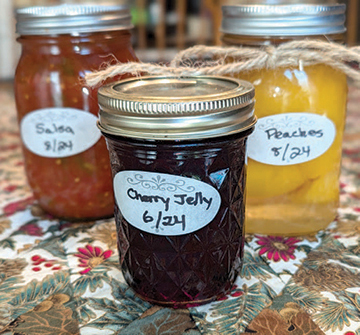
Helpful Hints for Gifting Home-Preserved Goodies
 Many home-preservers share their products with others. Holiday gifts might include a basket of home-canned foods such as jelly or salsa. However, remember that you are responsible for the safety of the foods you are sharing. That safety starts with a tested recipe from a trusted, reliable resource.
Many home-preservers share their products with others. Holiday gifts might include a basket of home-canned foods such as jelly or salsa. However, remember that you are responsible for the safety of the foods you are sharing. That safety starts with a tested recipe from a trusted, reliable resource.
If you are canning specifically for gifting, consider using jars in interesting sizes or shapes. It is important to make sure the jars are safe for canning – meaning Mason-type, with two-piece lids. There are many jars that look like canning jars that are not treated for the heat and temperature changes of home canning. These jars could still be used for packaging dried foods, just not for canning. If your jars are between traditional sizes, always process them at the same time for the next larger size jar that has canning guidelines to ensure safety. You certainly don’t want to under-process anything!
Once you have your foods prepared, now it’s time to package and label them. Here’s where you can get really creative! You can purchase or download/create and print decorative labels in so many shapes and styles. There is a lot of important information to include: the date the food was prepared; how long the food will last unopened and opened; storage instructions; and ingredients (especially if the product contains allergens). Add fabric or ribbon to the jar lids. Put it all in a reusable basket. If you happen to be shipping your goodies, the biggest concern is including plenty of padding in the shipping package, so no containers break. Remember to mark the package as “Fragile”.
Here are some ideas of cozy feeling home-canned products that make good gifts:
- Apples – Spiced Apple Rings, Apple Butter, Apple Marmalade, Apple Chutney
- Cranberries – Cranberry Sauce, Cranberry Marmalade, Cranberry Conserve, Cranberry Orange Chutney
- Pumpkin – Pumpkin Leather, Pumpkin Seeds
Happy Homemade Holidays!
Canning Soup for Cooler Seasons
 When autumn arrives and the weather cools in many areas of the U.S., people may opt for bowls of hot soup more often on their menus. Can soup made with this year’s fresh produce be canned in preparation for a cooler season?
When autumn arrives and the weather cools in many areas of the U.S., people may opt for bowls of hot soup more often on their menus. Can soup made with this year’s fresh produce be canned in preparation for a cooler season?
The answer is yes, soups made with vegetables, dry edible beans, meat, poultry and seafood can be canned safely. We need to closely follow the guidance from the U.S. Department of Agriculture’s “Complete Guide to Home Canning” and other information available from the National Center for Home Food Preservation.
We cannot, however, make the same type of thick canned soup with noodles and rice as you might buy at the grocery store in cans. In order to make a safe product, soup and other foods must be processed for the correct amount of time at the recommended pressure. Be sure to remember some tips.
- Follow the pressure canning recommendations for making soup. Do not thicken the soup with flour, rice or pasta, because the thickness of the soup can affect the heat penetration during processing and the safety of the soup.
- When filling jars to make homemade canned soup, fill the jars only halfway with the solids. Add the liquid ingredients and leave one inch of headspace, then process as directed.
- Try making your own chicken, turkey or beef stock. This involves the simmering process of the bones with water, with the time dependent on the type of meat, followed by pressure canning. For example, quarts of meat stock would be packed hot, then processed for 25 minutes at 10 pounds of pressure at 0 to 1,000 feet, or 15 pounds of pressure if above 1,000 feet. The broth can be combined with other ingredients for delicious stews, chili and soup.
- One exception: When properly acidified with citric acid or bottled lemon juice, tomatoes can be canned in a boiling water bath canner. After opening the jars, the resulting tomatoes can be used to make tomato soup with added thickeners, milk, cream and other ingredients.
- If you prefer not to can soup, remember that you can freeze the food in meal-sized containers.